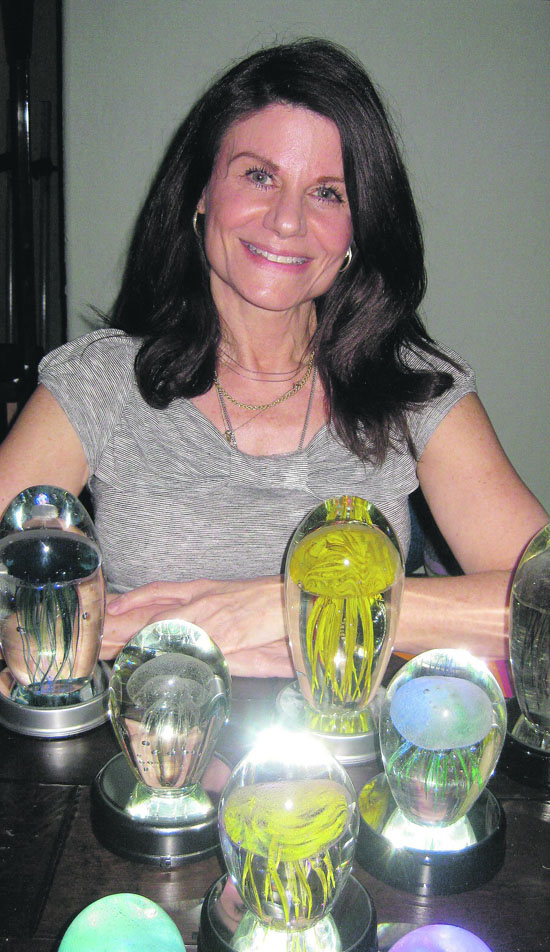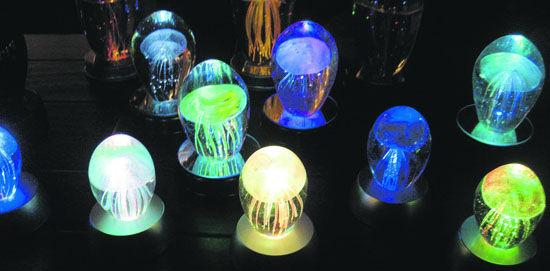 | | | Alison Klippel creates lights made with jellyfish that have died naturally. Photos Chris Lavin | | | | | | Lafayette artist Alison Klippel doesn’t believe in killing a single jellyfish, even in the name of art.
 “All our jellyfish live natural lives,” she said. “Some people tell me they tried to keep jellyfish as pets but they would only live for about six months. There’s something wrong. They have much longer life spans than that.” “All our jellyfish live natural lives,” she said. “Some people tell me they tried to keep jellyfish as pets but they would only live for about six months. There’s something wrong. They have much longer life spans than that.”
 Using jellyfish raised in enormous saltwater tanks by her extended family on Maui, Klippel creates magical looking lights, reminiscent of the lava lamps of yesteryear. Smaller versions are used as paperweights. Using jellyfish raised in enormous saltwater tanks by her extended family on Maui, Klippel creates magical looking lights, reminiscent of the lava lamps of yesteryear. Smaller versions are used as paperweights.
 “Everything is done by hand,” Klippel said during a visit to her Pleasant Hill Pilates studio. (She also teaches.) After the jellyfish dies, someone on Maui scoops it up from the bottom of the tank and ships it to her. They don’t all reach Klippel intact. “They’re very delicate,” she said. “The tentacles can break … they’re mostly all water.” “Everything is done by hand,” Klippel said during a visit to her Pleasant Hill Pilates studio. (She also teaches.) After the jellyfish dies, someone on Maui scoops it up from the bottom of the tank and ships it to her. They don’t all reach Klippel intact. “They’re very delicate,” she said. “The tentacles can break … they’re mostly all water.”
 Mostly Klippel uses moon jellies, a variety that lives near the ocean surface. But she also uses black, deep-water jellies, tiger jellies, and more. Mostly Klippel uses moon jellies, a variety that lives near the ocean surface. But she also uses black, deep-water jellies, tiger jellies, and more.
 Once a jellyfish dies, it is frozen, “to preserve its shape.” On some, Klippel might use a colored dye. Then she makes a clay mold by hand, puts in the jellyfish, then pours a resin into the mold. The jellyfishes’ ultimate preservation could be attributed to NASA, the space agency that brought us Velcro, “memory foam,” and hand-held vacuum cleaners. “The resin was designed for the space shuttle program,” Klippel said. “You can’t have glass windows on a space shuttle.” Once a jellyfish dies, it is frozen, “to preserve its shape.” On some, Klippel might use a colored dye. Then she makes a clay mold by hand, puts in the jellyfish, then pours a resin into the mold. The jellyfishes’ ultimate preservation could be attributed to NASA, the space agency that brought us Velcro, “memory foam,” and hand-held vacuum cleaners. “The resin was designed for the space shuttle program,” Klippel said. “You can’t have glass windows on a space shuttle.”
 When the resin dries, Klippel chips off the mold to see what she’s got. Often, it’s “voila!” and a beautiful jellyfish appears to swim in perpetuity, amid what looks like air bubbles. “But the bubbles aren’t air,” Klippel says. “They’re actually nitrogen bubbles given off by the jellyfish itself.” The specimens look beautiful on their own, but Klippel prefers to set them on one of three stands she uses, including a seven-light LED stand that changes colors. “They allow the light to pass through the jellyfish.” And when the light is turned off, it’s another “voila,” because the jellyfish will glow in the dark. When the resin dries, Klippel chips off the mold to see what she’s got. Often, it’s “voila!” and a beautiful jellyfish appears to swim in perpetuity, amid what looks like air bubbles. “But the bubbles aren’t air,” Klippel says. “They’re actually nitrogen bubbles given off by the jellyfish itself.” The specimens look beautiful on their own, but Klippel prefers to set them on one of three stands she uses, including a seven-light LED stand that changes colors. “They allow the light to pass through the jellyfish.” And when the light is turned off, it’s another “voila,” because the jellyfish will glow in the dark.
 While Klippel’s specimens live natural lives, it would be a stretch to call them “happy.” For 600 million years, jellyfish have lived as plankton live, floating with the tides and currents. They don’t have brains. They don’t even really have sex. “The female lays her eggs and the male fertilizes them in the water,” Klippel said. Kind of like trout. Or salmon. She has no idea how many generations of jellyfish they have raised, but it’s probably hundreds. While Klippel’s specimens live natural lives, it would be a stretch to call them “happy.” For 600 million years, jellyfish have lived as plankton live, floating with the tides and currents. They don’t have brains. They don’t even really have sex. “The female lays her eggs and the male fertilizes them in the water,” Klippel said. Kind of like trout. Or salmon. She has no idea how many generations of jellyfish they have raised, but it’s probably hundreds.
 Something about Klippel’s creations is mesmerizing. From her small paperweights of just a few inches to her larger ones that reach about a foot tall, they seem to float, a passenger riding a tide. They seem to glide and puff while they … think. Something about Klippel’s creations is mesmerizing. From her small paperweights of just a few inches to her larger ones that reach about a foot tall, they seem to float, a passenger riding a tide. They seem to glide and puff while they … think.
 Klippel sometimes receives notes from people who have her jellyfish. “They’ll say ‘I’m meditating to my jellyfish,’ or ‘I’m having wine with my jellyfish!’” she said. “I love getting those notes.” Klippel sometimes receives notes from people who have her jellyfish. “They’ll say ‘I’m meditating to my jellyfish,’ or ‘I’m having wine with my jellyfish!’” she said. “I love getting those notes.”
 Klippel’s creations can be seen at www.raphaeloriginals.com. Klippel’s creations can be seen at www.raphaeloriginals.com. |

